

Getting started with the Atmosphere Framework part II: Writing a REST application with Comet support. This time I will demonstrate how easy and dead simple is to write a REST application using Atmosphere annotations…with the help of Jersey!
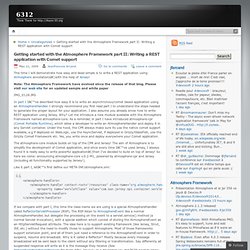
Note: The Atmosphere Framework have evolved since the release of that blog. Please visit our web site for an updated sample and white paper In part I I’ve described how easy it is to write an asynchronous/comet based application using an AtmosphereHandler. I strongly recommend you first read part I to understand the steps needed to generate the proper layout for your application. I also assume you already know how to write REST application using Jersey. The atmosphere-core module builds on top of the CPR and Jersey! Like it part I, let’s first define our META-INF/atmosphere.xml: Next step is to write the web.xml: Atmosphere/atmosphere. Code example - PubSub xref.
Build a RESTful Web service using Jersey and Apache Tomcat. RESTful Web service introduction Representational State Transfer, or REST, was introduced and defined in 2000 by the doctoral dissertation of Roy Fielding, one of the principal authors of the HTTP specification versions 1.0 and 1.1.
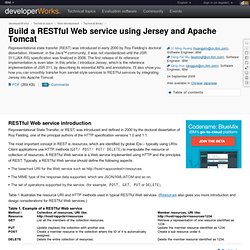
The most important concept in REST is resources, which are identified by global IDs— typically using URIs. Client applications use HTTP methods (GET/ POST/ PUT/ DELETE) to manipulate the resource or collection of resources. A RESTful Web service is a Web service implemented using HTTP and the principles of REST. Typically, a RESTful Web service should define the following aspects: The base/root URI for the Web service such as MIME type of the response data supported, which are JSON/XML/ATOM and so on. Table 1 illustrates the resource URI and HTTP methods used in typical RESTful Web services. Table 1. Back to top JSR 311 (JAX-RS) and Jersey In the following sections of the article, I introduce all of these components, but will focus more on the Core Server. Jersey 1.5 User Guide. Chapter 1.
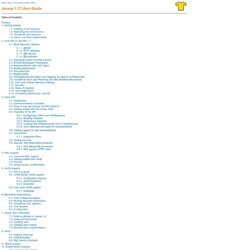
Getting Started This chapter will present how to get started with Jersey using the embedded Grizzly server. The last section of this chapter presents a reference to equivalent functionality for getting started with a Web application. First, it is necessary to depend on the correct Jersey artifacts as described in Chapter 11, Maven developers require a dependency on The following dependencies need to be added to the pom:
JAX-RS ou Comment créer et utiliser des services RESTful en 10 min ? En 2 mots, REST (Representation State Transfer) est un principe d’architecture applicative qui s’appuie sur les principes fondateurs du Web : les URI qui représentent des ressources auxquelles votre application se réfèreLe protocole HTTP et ses méthodes GET, PUT, PUT et DELETE qui permettent d’interagir avec ces ressourcesLa dimension « Stateless » permet d’assurer une montée en charge sans limiteLes mime type qui permettent de décrire le contenu d’une interaction Alors évidemment vous ne pourrez pas découvrir automatiquement dans un annuaire un service REST ; vous ne pourrez pas dynamiquement faire correspondre son contenu à un objet construit dynamiquement ; vous ne pourrez pas l’implémenter sur tout un ensemble de protocoles de MQSeries à IMAP/SMTP en passant par SOAP ; vous ne gèrerez pas la sécurité, les transactions, les attachements, les versions ou la sémantique… Bref, REST ça veut dire simple et ultra facile à intégrer !
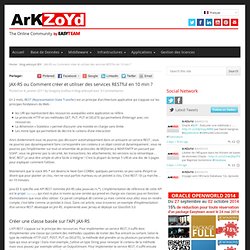
Créer une classe basée sur l’API JAX-RS. JAX-RS as the one Java web framework to rule them all? One of the things about Java that sometimes gets made fun of is the huge number of Java based web frameworks.
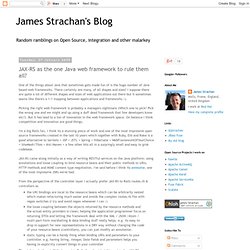
There certainly are many, of all shapes and sizes! I suppose there are quite a lot of different shapes and sizes of web applications out there but it sometimes seems like there's a 1-1 mapping between applications and frameworks :). Picking the right web framework is probably a managers nightmare (Which one to pick? Pick the wrong one and we might end up using a duff dead framework that few developers know etc?). But it has lead to a ton of innovation in the web framework space. Using JAX-RS (Jersey) to build a JPA/JAXB-backed JSON REST API. Building applications for deployment to the web has evolved over the last several years to be focused on dynamic behavior, separation of model/view/controller, and simplified but scalable configuration and deployment.
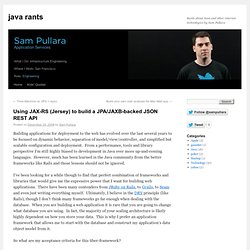
From a performance, tools and library perspective I’m still highly biased to development in Java over more up-and-coming languages. However, much has been learned in the Java community from the better frameworks like Rails and those lessons should not be ignored. I’ve been looking for a while though to find that perfect combination of frameworks and libraries that would give me the expressive power that I want for building web applications.
There have been many contenders from JRuby on Rails, to Grails, to Seam and even just writing everything myself. Ultimately, I believe in the DRY principle (like Rails), though I don’t think many frameworks go far enough when dealing with the database. All very declarative and readable.